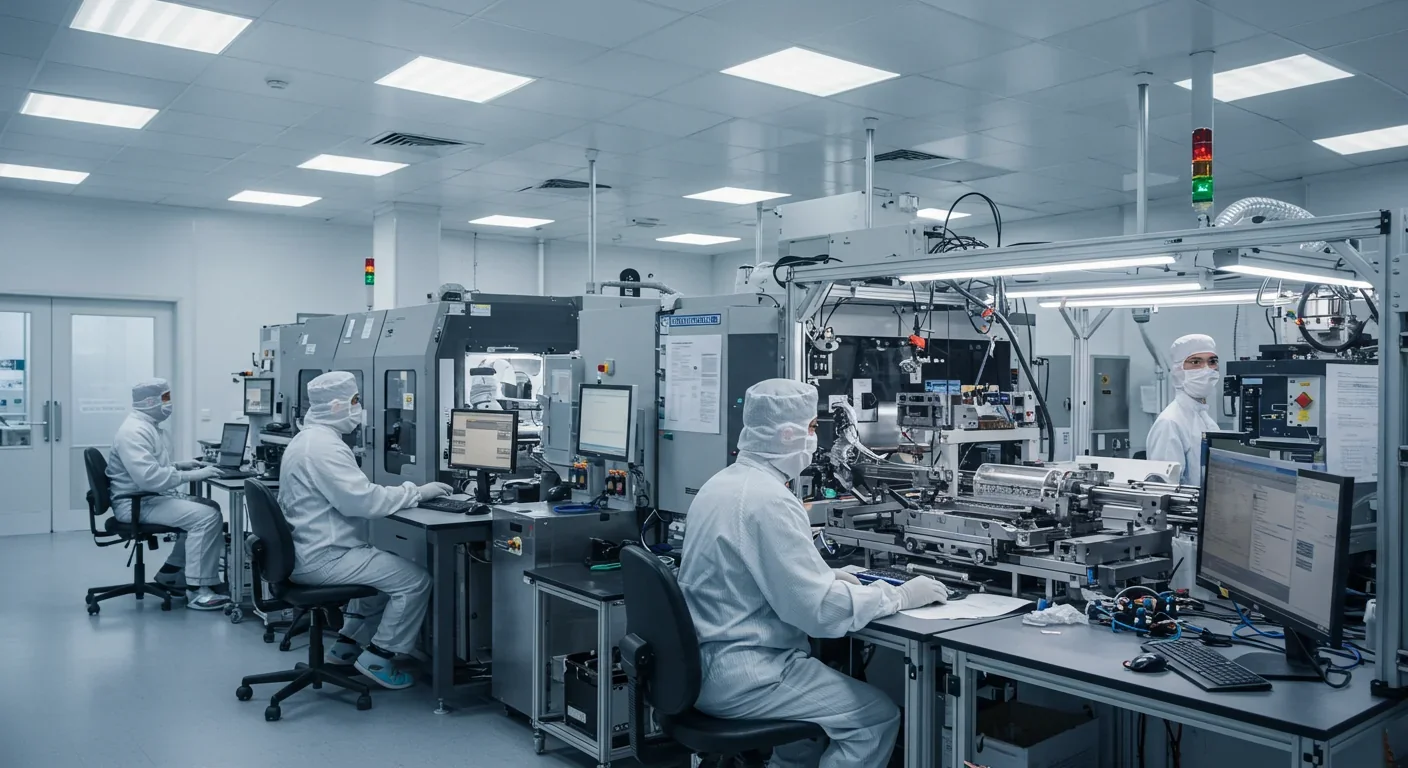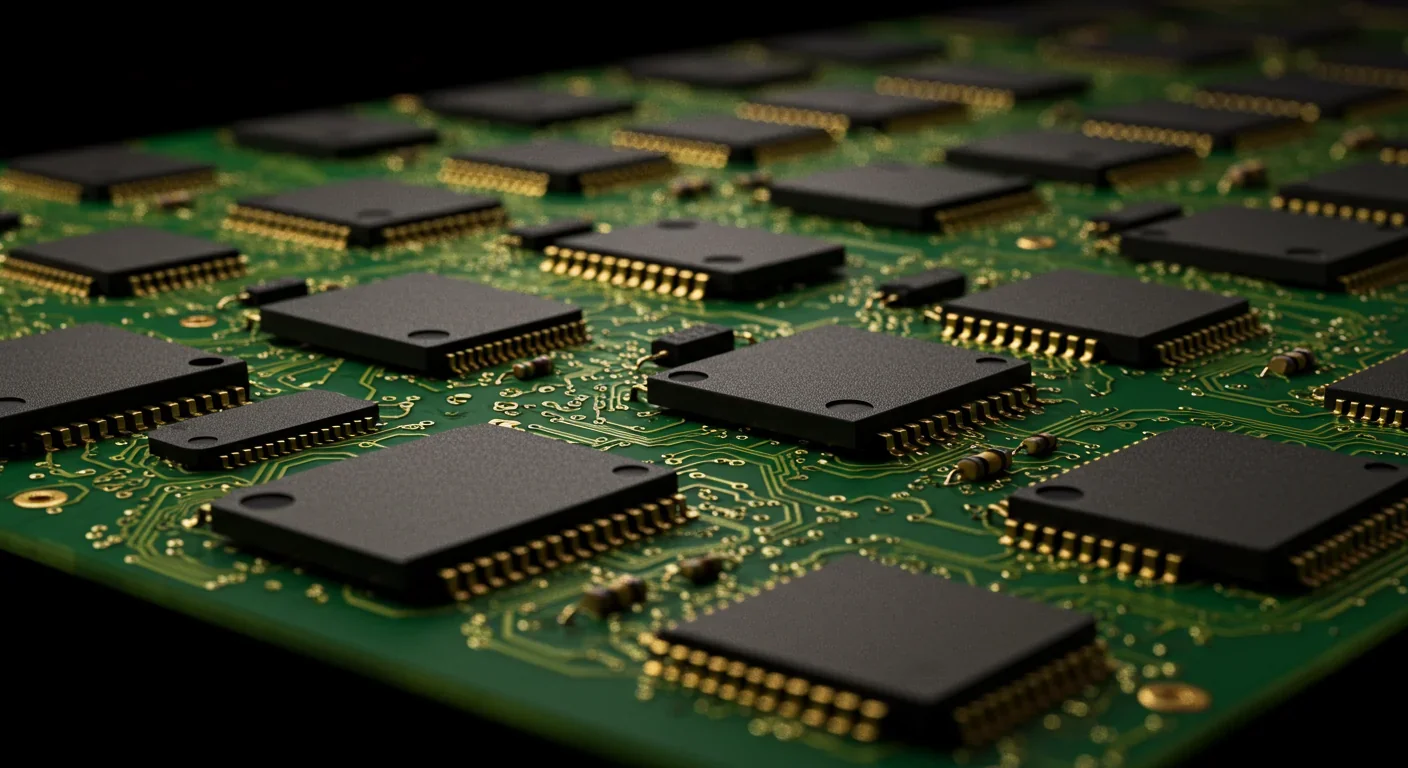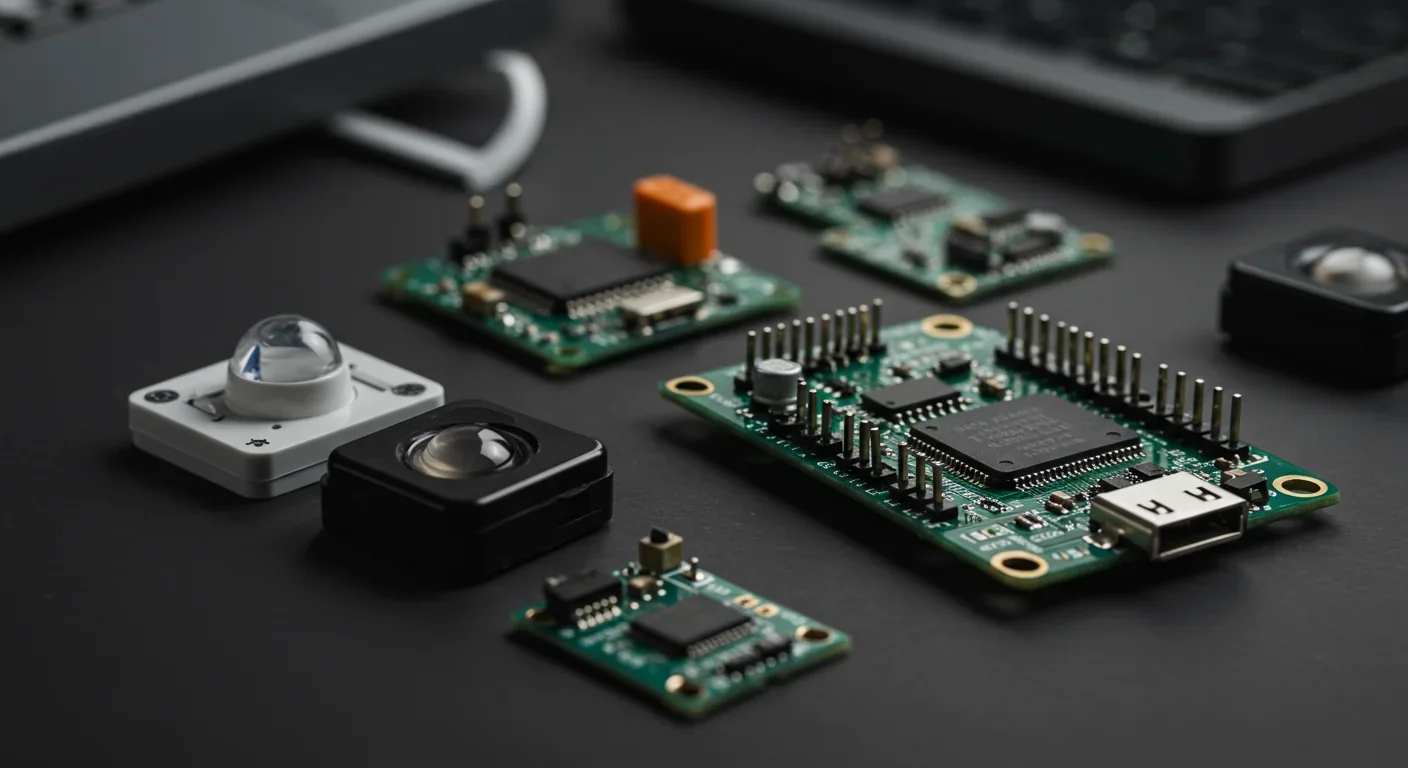Zero-Trust Security Revolution: Verify Everything Always

TL;DR: RISC-V, the open-source processor architecture born at UC Berkeley, is capturing 25% of the global chip market by 2030—challenging Intel and ARM's decades-long duopoly through zero licensing fees, unlimited customization, and backing from tech giants like Google, Qualcomm, and Alibaba.
By 2030, nearly one in three new processor designs worldwide will be based on an architecture that didn't exist commercially a decade ago. This isn't speculation from futurists but the calculated projection from chip industry analysts watching RISC-V's meteoric rise. The open-source instruction set architecture, born in a UC Berkeley computer lab in 2010, is on track to capture 25% of the global processor market ahead of its own ambitious schedule. For the first time in decades, the Intel-ARM duopoly faces a credible challenger that plays by completely different rules—and the implications reach far beyond chip design into geopolitics, economics, and technological sovereignty.

What started as an academic exercise to teach computer architecture has evolved into a movement backed by Google, Qualcomm, Alibaba, and thousands of engineers worldwide. Unlike every major processor architecture before it, RISC-V doesn't belong to any single company. There are no licensing fees, no royalty payments, no geographic restrictions. Anyone can design a RISC-V chip, modify it for their specific needs, and manufacture it without asking permission or paying tribute to Silicon Valley gatekeepers.
This fundamental difference explains why China's government is aggressively promoting RISC-V adoption, why European consortiums are building RISC-V supercomputers, and why even Intel—the company synonymous with x86 processors—has begun offering RISC-V chip manufacturing services. The question isn't whether RISC-V will matter, but how thoroughly it will reshape the semiconductor landscape.
The RISC-V story begins with a problem familiar to anyone who has taught computer architecture: proprietary instruction sets are terrible for education and research. In 2010, UC Berkeley professors Krste Asanović and David Patterson needed a clean, simple instruction set for their students to study without legal restrictions or licensing complications. They built RISC-V—the fifth generation of "Reduced Instruction Set Computer" designs—as a teaching tool.
But they did something unusual. Instead of keeping it within Berkeley's walls, they released the specification under open-source licenses that allowed anyone to implement it royalty-free. This single decision transformed RISC-V from an academic curiosity into the foundation for a technological revolution.
The timing proved perfect. The smartphone era had established ARM as the dominant architecture for mobile devices, but ARM's business model required licensing fees and royalty payments that scaled with product volume. Meanwhile, Intel's x86 architecture remained locked in the PC and server markets, protected by decades of patents and a software ecosystem so entrenched that switching seemed impossible.
RISC-V offered an escape route. Companies could customize the architecture for their specific needs without negotiating license terms or worrying about royalty costs on every chip sold. For startups and researchers, it eliminated the barrier to entry. For giants like Google and Alibaba building billions of specialized chips for data centers, it promised enormous cost savings.
By 2030, RISC-V is projected to capture 25% of the global processor market—a stunning achievement for an architecture that barely existed commercially fifteen years earlier.
By 2015, interest had grown sufficiently that the RISC-V Foundation was established to maintain the specification and coordinate development. Today, RISC-V International boasts over 4,500 members from more than 70 countries—a testament to how quickly the architecture has gained global momentum.
To understand RISC-V's appeal, you need to grasp what an instruction set architecture actually does. Think of it as the vocabulary a processor understands—the basic commands it can execute. Every program, no matter how complex, eventually gets translated into these fundamental instructions.
x86, ARM, and RISC-V represent three different philosophies about what that vocabulary should look like. Intel's x86 architecture emerged in the 1970s and accumulated decades of backward compatibility requirements, resulting in thousands of complex instructions. ARM took a "reduced instruction set" approach with simpler, more uniform commands optimized for power efficiency. RISC-V pushes simplification even further with a modular design where manufacturers implement only the instructions they need.

This modularity gives RISC-V unprecedented flexibility. A chip designed for a smart doorbell can implement only the basic instructions, keeping it tiny and cheap. A high-performance server processor can add advanced instructions for encryption, vector processing, or AI acceleration. Both are valid RISC-V chips, but each is optimized for its specific purpose without carrying unnecessary baggage.
The technical advantages extend beyond flexibility. RISC-V's clean design, unburdened by decades of legacy cruft, allows for more efficient implementation. Chips can be smaller, consume less power, or run faster than equivalent designs shackled to older architectures. For applications where every milliwatt matters—IoT sensors, wearables, edge devices—these advantages translate directly to longer battery life and lower costs.
Perhaps most importantly for engineers, RISC-V's open specification means complete transparency. There are no secret instructions, no undocumented behaviors, no mystery features that only the architecture owner knows about. Security researchers can audit the entire design. Compiler writers can optimize without guesswork. Hardware designers understand exactly what they're implementing.
The shift from academic project to commercial powerhouse accelerated dramatically after 2018. That year, Western Digital announced it would transition all its devices to RISC-V, committing to ship over a billion RISC-V cores annually. The storage giant wasn't making this move for ideological reasons—it calculated that RISC-V's customizability and zero royalty costs would save tens of millions of dollars while delivering better performance for its specific workloads.
The announcement signaled to the industry that RISC-V had crossed the threshold from interesting experiment to viable commercial architecture. Others followed quickly.
Google integrated RISC-V into its Coral AI platform, recognizing that specialized AI accelerators benefit enormously from customized instruction sets. Qualcomm unveiled RISC-V-based modules for IoT applications, explicitly citing the need to escape ARM's licensing costs as chip volumes skyrocket. Nvidia, despite its massive ARM acquisition attempt, began using RISC-V cores in its graphics cards for specialized control tasks.
"The openness of the RISC-V ISA allows rapid, low-cost customization and optimization that is highly attractive for embedded and IoT applications, explaining its early and strong penetration in these markets."
— Industry Analysis from RISC-V Market Research
The roster reads like a who's who of computing: Alibaba built RISC-V chips for its cloud infrastructure. Samsung and Qualcomm announced they would jointly invest in RISC-V development to reduce ARM dependency. Startups like SiFive and Ventana Micro emerged to provide RISC-V chip designs and development tools, attracting hundreds of millions in venture funding.

Even Intel, whose entire business model revolves around its x86 monopoly, joined the RISC-V party—not by abandoning x86, but by offering to manufacture RISC-V chips for others through Intel Foundry Services. The move reflects brutal realism: if RISC-V is coming regardless, Intel might as well profit from making the chips.
Europe sees RISC-V as strategic infrastructure. The TRISTAN project aims to build European supercomputers on RISC-V architecture, explicitly motivated by desires for technological sovereignty independent of American or Chinese chip companies. France, Germany, and other EU nations are funding RISC-V research and development as a matter of national security.
This isn't just about existing companies adopting new technology. RISC-V is enabling entirely new entrants. AheadComputing, founded by former Intel engineers, is building high-performance RISC-V cores specifically designed to challenge Intel's and AMD's dominance in servers. The barriers that once protected the processor market—patents, ecosystem lock-in, manufacturing complexity—are crumbling.
Nowhere has RISC-V adoption been more aggressive than in China. After years of U.S. trade restrictions limiting Chinese companies' access to advanced American chip technology, Beijing has made RISC-V central to its semiconductor self-sufficiency strategy.
The logic is straightforward. You can sanction x86 licenses and ARM designs, but you can't sanction an open standard. RISC-V specifications are publicly available, legally implementable by anyone, and increasingly backed by a global community that transcends any single nation's control. For China, this represents an unhackable path to advanced processors.
Chinese RISC-V development has progressed with startling speed. The country recently unveiled its first RISC-V server CPU, a milestone that demonstrates RISC-V's expansion beyond embedded systems into enterprise computing. Chinese smartphone makers are designing RISC-V applications processors. Universities are teaching RISC-V as the standard architecture. Government procurement increasingly favors RISC-V designs.
China's aggressive RISC-V investment creates a geopolitical paradox: American restrictions on chip technology are inadvertently accelerating the development of an open-source alternative that benefits global competitors.
This creates a geopolitical feedback loop. As China invests billions into RISC-V development, it improves the architecture's software ecosystem, development tools, and real-world implementations. These improvements benefit everyone using RISC-V globally, accelerating adoption in other countries, which in turn motivates more investment. The open-source nature means American and European engineers can use innovations developed in Beijing, and vice versa, creating a genuinely global technical platform.
Western policymakers find themselves in a bind. They can't restrict RISC-V without appearing to oppose open standards and academic freedom. Attempts to control the technology would likely backfire, fragmenting development while accelerating Chinese independence. Yet allowing unfettered development means potentially enabling rivals to achieve semiconductor self-sufficiency.

The RISC-V International organization tried to navigate these tensions by relocating from the United States to Switzerland in 2019, explicitly positioning itself as neutral technical ground. Still, the reality remains: RISC-V has become a major front in technological competition between the world's powers.
Despite RISC-V's momentum, predictions of x86 and ARM's imminent demise are premature. The processor market is fragmenting rather than consolidating around a single winner, with RISC-V projected to capture 25% market share by 2030—significant, but leaving three-quarters for incumbents.
Understanding why requires examining where each architecture excels. x86 remains entrenched in PCs and servers because of decades of software optimization and the enormous installed base of Windows and Linux applications compiled for Intel's instruction set. No company is rewriting Microsoft Office or Adobe Photoshop for RISC-V anytime soon. The switching costs are simply too high for existing ecosystems.
ARM similarly dominates smartphones through a combination of power efficiency, mature software, and deep integration with companies like Apple and Qualcomm. Every major mobile operating system, development tool, and application expects ARM processors. RISC-V faces a chicken-and-egg problem: developers won't optimize for RISC-V until there's significant market share, but market share requires optimized software.
Where RISC-V excels is in new applications without established ecosystems. IoT devices, embedded systems, and specialized accelerators are natural fits because they often run custom software anyway. Market projections suggest RISC-V could reach $11.50 billion in value by 2032, growing at nearly 30% annually—but much of this comes from markets that didn't previously use ARM or x86.
The real disruption may be in preventing Intel and ARM from expanding into new territories. As computing becomes increasingly specialized—with AI accelerators, edge processors, automotive chips, and custom data center silicon—RISC-V offers an alternative path that doesn't require paying tribute to established players. This caps the total addressable market for x86 and ARM without necessarily displacing their current strongholds.
Industry analysts increasingly describe the future as multimodal: x86 for traditional PCs and servers where software compatibility matters most, ARM for mobile devices and increasingly for efficiency-focused computing, RISC-V for specialized applications, embedded systems, and markets where customization or cost structures favor open architectures. Rather than a single winner, we're seeing architectural diversity driven by application-specific needs.
For all its technical elegance and business advantages, RISC-V faces a sobering reality: decades of software development, toolchain optimization, and developer familiarity separate "works in the lab" from "trusted for production."

Consider what it takes to truly support a processor architecture. Operating systems must be ported and optimized. Compilers need to generate efficient code for the specific instruction set. Debuggers, profilers, and development tools require architecture-specific implementations. Standard libraries and frameworks expect certain performance characteristics. Device drivers must be rewritten. Security tools need updating. The list continues for pages.
ARM didn't become the mobile standard overnight—it took fifteen years of continuous investment after the first ARM smartphones appeared. x86's dominance reflects forty years of accumulated software. RISC-V, despite rapid progress, still lags in compiler maturity, operating system optimization, and the myriad small details that determine whether software runs adequately or excellently.
The good news: major Linux distributions now support RISC-V, providing a foundation for further development. Android is being ported to RISC-V, with working demonstrations already available. Compiler toolchains from GCC and LLVM have basic RISC-V support. These aren't trivial achievements—they represent thousands of hours of engineering from companies that believe RISC-V will matter.
The challenge: "basic support" differs enormously from the highly optimized implementations that x86 and ARM enjoy. A compiler might generate working RISC-V code but miss optimization opportunities that would be caught automatically for x86. Libraries might function correctly but run slower due to assumptions baked in from years of ARM development. These gaps close through sustained effort and real-world usage, but expecting overnight parity is unrealistic.
The software ecosystem—not hardware performance—remains RISC-V's biggest challenge. Decades of optimization separate "good enough" from "production ready."
RISC-V International and its members are investing heavily to accelerate ecosystem maturity. Regular developer conferences share optimization techniques. Companies like SiFive provide development boards at near-cost to encourage experimentation. Universities increasingly teach computer architecture using RISC-V, building a generation of engineers native to the platform.
Performance benchmarks tell the story of rapid but incomplete progress. Current RISC-V implementations match or exceed ARM in specific embedded workloads where customization advantages outweigh ecosystem maturity. In general-purpose computing, RISC-V still trails, sometimes significantly, though the gap narrows with each generation.
Neither ARM nor Intel is sitting idle while RISC-V gains momentum. Both have launched initiatives to blunt RISC-V's competitive advantages while doubling down on their respective strengths.
ARM's response has been multifaceted. The company introduced more flexible licensing terms for certain applications, allowing greater customization—a direct acknowledgment of RISC-V's appeal. ARM has accelerated its technology roadmap, pushing efficiency improvements and new instruction set extensions to maintain technical leadership. The company also emphasizes its mature ecosystem as the key differentiator, running advertising campaigns that essentially argue: "Yes, RISC-V is cheaper, but can you afford the integration costs?"
Some analysts see ARM's aggressive push for its Armv9 architecture, with built-in AI acceleration and improved efficiency, as a response to RISC-V's customization advantages. By making the standard ARM architecture more capable and flexible, ARM hopes to reduce the incentive for companies to build custom RISC-V solutions. Time will tell whether this strategy succeeds or merely delays the inevitable shift.
Intel's position is more complex. The company faces existential challenges beyond RISC-V, including manufacturing difficulties and market share losses to AMD. Yet Intel has made strategic moves that acknowledge RISC-V's importance without abandoning x86.
Intel Foundry Services' willingness to manufacture RISC-V chips represents a calculated pivot. If Intel can't convince everyone to use x86, it can at least profit from the manufacturing process. This strategy assumes that Intel's technological lead in chip fabrication (a tenuous assumption at present) provides value regardless of architecture. It's pragmatic but represents a significant philosophical shift for a company that built its empire on architectural lock-in.
Meanwhile, Intel continues pouring billions into x86 development, betting that raw performance and software compatibility will maintain its data center and PC strongholds even as embedded markets shift to RISC-V. The company has also explored x86 licensing more actively, a move unthinkable a decade ago, suggesting recognition that total control may no longer be tenable.
"You can't outspend thousands of engineers working in parallel on open-source development. That's the fundamental challenge facing both ARM and Intel."
— Semiconductor Industry Analyst
Both companies face a fundamental challenge: RISC-V's open nature means competition isn't against a single rival but against an ecosystem of competitors, each optimizing for different niches, collectively outmaneuvering slower-moving traditional players. You can't outspend thousands of engineers working in parallel on open-source development.
Follow the money to understand RISC-V's true impact. The semiconductor industry's traditional economic structure funneled enormous profits to a few dominant players—Intel, ARM, Qualcomm—who controlled critical intellectual property. RISC-V threatens to redistribute this value chain dramatically.
Consider ARM's business model. The company designs processor architectures but doesn't manufacture chips. Instead, it licenses designs to others and collects royalties on every chip sold. In 2023, ARM earned over $3 billion largely from these licensing fees and royalties. Market projections suggest RISC-V could capture markets worth tens of billions annually, representing direct displacement of ARM's revenue in specific segments.
For chip designers and manufacturers, RISC-V's royalty-free model means keeping more value internally. A company shipping 100 million chips annually might save $10-50 million in ARM licensing fees by switching to RISC-V, depending on the specific license terms. At scale, these savings justify significant engineering investment in RISC-V development.
But the economic shift extends beyond simple cost savings. RISC-V enables business models that weren't viable under ARM or x86. Startups can design custom chips without negotiating licenses or paying upfront fees, lowering barriers to entry in hardware innovation. Universities and researchers can experiment with novel architectures without legal constraints. Developing countries can build semiconductor industries without paying royalties to Western or Asian incumbents.
This democratization of chip design doesn't just move money around—it potentially expands the market by enabling applications that previously didn't make economic sense. If designing a custom processor for a specialized application becomes cheap enough, industries from automotive to medical devices can optimize hardware in ways that weren't cost-effective when using off-the-shelf ARM or x86 chips.
Venture capital has noticed. Investments in RISC-V startups have surged, with companies like SiFive, Ventana, and others raising hundreds of millions in funding. The bet isn't just that RISC-V will displace existing chips but that it will enable an entire category of semiconductor innovation previously suppressed by high entry barriers.
Market research firms project the RISC-V market growing at 29-30% annually, faster than the semiconductor market overall, indicating genuine market expansion rather than pure substitution. Some of this comes from new IoT devices and edge computing applications that create fresh demand. Some comes from specialized AI accelerators that might have used alternative architectures or wouldn't have been built at all under traditional cost structures.
The economic winners in this transition may not be the companies building RISC-V chips but those using RISC-V chips to deliver better, cheaper, or more innovative products. Just as open-source software's biggest winners were companies like Google and Amazon building services on Linux rather than Red Hat selling distributions, RISC-V's value may accrue to those leveraging the technology rather than selling it directly.
For technology professionals, the rise of RISC-V signals a return to architectural diversity not seen since the 1990s. Engineers entering the field today should expect to work with multiple instruction set architectures over their careers, not just the x86 or ARM they might have learned in school.
This shift demands new skills. Understanding instruction set architecture principles becomes more important than memorizing specific x86 or ARM details. Cross-platform development skills—writing code that performs well across different architectures—will be increasingly valuable. Hardware-software co-design, where application requirements directly influence processor architecture choices, will become more common as customization costs drop.
Companies must develop architecture strategy where previously they could simply default to Intel or ARM. Decisions about which architecture to use for which applications will increasingly depend on specific technical and business requirements rather than default industry standards. This creates both opportunity and complexity: freedom to optimize, but responsibility to make informed choices.
Will RISC-V "take over" from Intel and ARM? The question itself misframes the situation. We're not witnessing one dominant architecture replacing another but rather the fracturing of processor markets into specialized niches where different architectures excel based on specific requirements.
x86 will remain entrenched in traditional computing where decades of software optimization and compatibility matter most. ARM will continue dominating mobile and expanding into servers and PCs where efficiency and ecosystem maturity provide advantages. RISC-V will capture embedded systems, IoT, specialized accelerators, and new applications where customization and cost structures favor open architectures.
The revolutionary aspect isn't technological displacement but the end of architectural oligopoly. For the first time in decades, companies, countries, and developers have genuine choice in processor architecture without requiring permission from or payment to a dominant vendor. This freedom to innovate, customize, and optimize for specific use cases represents the true disruption RISC-V brings.
By achieving 25% market penetration ahead of schedule, RISC-V has already proven it's more than an academic curiosity or niche alternative. It's a permanent fixture of the semiconductor landscape, growing steadily as new applications emerge and existing markets mature.
The future of computing won't be written in a single instruction set. It will be a polyglot ecosystem where x86, ARM, and RISC-V coexist, each dominant in specific domains, with the balance shifting as technology evolves and new requirements emerge. For an industry that spent decades under the control of a few architectural gatekeepers, this diversity represents not just technical progress but a fundamental democratization of hardware innovation.
The revolution isn't complete—it's just beginning. And unlike previous processor transitions that anointed new monarchs, this one distributes power rather than concentrates it. That may be RISC-V's most lasting legacy.

Lunar mass drivers—electromagnetic catapults that launch cargo from the Moon without fuel—could slash space transportation costs from thousands to under $100 per kilogram. This technology would enable affordable space construction, fuel depots, and deep space missions using lunar materials, potentially operational by the 2040s.

Ancient microorganisms called archaea inhabit your gut and perform unique metabolic functions that bacteria cannot, including methane production that enhances nutrient extraction. These primordial partners may influence longevity and offer new therapeutic targets.

CAES stores excess renewable energy by compressing air in underground caverns, then releases it through turbines during peak demand. New advanced adiabatic systems achieve 70%+ efficiency, making this decades-old technology suddenly competitive for long-duration grid storage.

Human children evolved to be raised by multiple caregivers—grandparents, siblings, and community members—not just two parents. Research shows alloparenting reduces parental burnout, improves child development, and is the biological norm across cultures.

Soft corals have weaponized their symbiotic algae to produce potent chemical defenses, creating compounds with revolutionary pharmaceutical potential while reshaping our understanding of marine ecosystems facing climate change.

Generation Z is the first cohort to come of age amid a polycrisis - interconnected global failures spanning climate, economy, democracy, and health. This cascading reality is fundamentally reshaping how young people think, plan their lives, and organize for change.

Zero-trust security eliminates implicit network trust by requiring continuous verification of every access request. Organizations are rapidly adopting this architecture to address cloud computing, remote work, and sophisticated threats that rendered perimeter defenses obsolete.